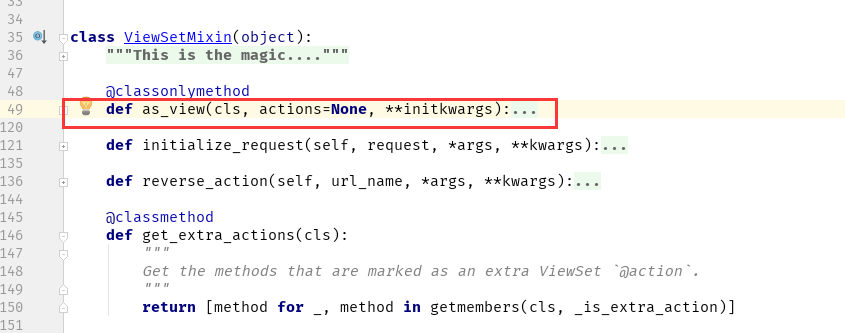在上一篇文章中我们已经分析了认证组件源码,我们再来看看权限组件的源码,权限组件相对容易,因为只需要返回True 和False即可
代码

1 class ShoppingCarView(ViewSetMixin, APIView): 2 permission_classes = [MyPermission, ] 3 def list(self,request, *args, **kwargs): 4 """ 5 查看购物车信息 6 :param args: 7 :param kwargs: 8 :return: 9 """ 10 try: 11 ret = BaseResponse() 12 pay_course_list = [] 13 # key = 'shoppingcar_%s_%s' % (USERID, '*') 14 key = settings.SHOPCAR_FORMAT.format( request.user.id, "*") 15 user_key_list = COON.keys(pattern=key) # 取到这个用户对应的所有课程字典 对应的键 16 for key in user_key_list: 17 # 对应的每个键值 去取每个课程对应的信息 和价格列表 18 temp = { 19 'id': COON.hget(key, 'id').decode('utf8'), 20 'name': COON.hget(key, 'name').decode('utf8'), 21 'img': COON.hget(key, 'img').decode('utf8'), 22 'default': COON.hget(key, 'default').decode('utf8'), 23 'price_dict': json.loads(COON.hget(key, 'price_dict').decode('utf8')), 24 } 25 pay_course_list.append(temp) 26 ret.data = pay_course_list 27 except Exception as e: 28 ret.data = '查看失败' 29 ret.code = 00000 30 return Response(ret.dict) 31 32 视图类

class MyPermission(BasePermission): message = 'VIP用户才能访问' def has_permission(self, request, view): """ 自定义权限只有VIP用户才能访问 """ # 因为在进行权限判断之前已经做了认证判断,所以这里可以直接拿到request.user if request.user and request.user.type == 2: # 如果是VIP用户 return True else: return False

urlpatterns = [ url(r'^payment/$', payment.PaymentView.as_view({'post': 'create','put': 'update','get':'list'})), ]
跟上一篇一样,来看代码是如何走到我自定义的权限类中的。
1.首先从url中分析
1.先来到视图类中的as.view()方法

而我们的自定义的方法中没有as.view()方法,那就要去父类ViewSetMixin和APIView中去找,好看源码
2.分析源码
1.先看ViewSetMixin类中

class ViewSetMixin(object):
"""
This is the magic.
Overrides `.as_view()` so that it takes an `actions` keyword that performs
the binding of HTTP methods to actions on the Resource.
For example, to create a concrete view binding the 'GET' and 'POST' methods
to the 'list' and 'create' actions...
view = MyViewSet.as_view({'get': 'list', 'post': 'create'})
"""
@classonlymethod
def as_view(cls, actions=None, **initkwargs):
"""
Because of the way class based views create a closure around the
instantiated view, we need to totally reimplement `.as_view`,
and slightly modify the view function that is created and returned.
"""
# The suffix initkwarg is reserved for displaying the viewset type.
# eg. 'List' or 'Instance'.
cls.suffix = None
# The detail initkwarg is reserved for introspecting the viewset type.
cls.detail = None
# Setting a basename allows a view to reverse its action urls. This
# value is provided by the router through the initkwargs.
cls.basename = None
# actions must not be empty
if not actions:
raise TypeError("The `actions` argument must be provided when "
"calling `.as_view()` on a ViewSet. For example "
"`.as_view({'get': 'list'})`")
# sanitize keyword arguments
for key in initkwargs:
if key in cls.http_method_names:
raise TypeError("You tried to pass in the %s method name as a "
"keyword argument to %s(). Don't do that."
% (key, cls.__name__))
if not hasattr(cls, key):
raise TypeError("%s() received an invalid keyword %r" % (
cls.__name__, key))
def view(request, *args, **kwargs):
self = cls(**initkwargs)
# We also store the mapping of request methods to actions,
# so that we can later set the action attribute.
# eg. `self.action = 'list'` on an incoming GET request.
self.action_map = actions
# Bind methods to actions
# This is the bit that's different to a standard view
for method, action in actions.items():
handler = getattr(self, action)
setattr(self, method, handler)
if hasattr(self, 'get') and not hasattr(self, 'head'):
self.head = self.get
self.request = request
self.args = args
self.kwargs = kwargs
# And continue as usual
# 前面都是在对传参做判断和重新赋值,重要的是下面这一步,最后return 调用了dispatch方法
return self.dispatch(request, *args, **kwargs)
2.找dispatch方法在哪里,答案肯定是在APIView中
def dispatch(self, request, *args, **kwargs):
"""
`.dispatch()` is pretty much the same as Django's regular dispatch,
but with extra hooks for startup, finalize, and exception handling.
"""
self.args = args
self.kwargs = kwargs
request = self.initialize_request(request, *args, **kwargs)
## request = Request(.....)
self.request = request
self.headers = self.default_response_headers
try:
self.initial(request, *args, **kwargs)
# Get the appropriate handler method
if request.method.lower() in self.http_method_names:
handler = getattr(self, request.method.lower(),
self.http_method_not_allowed)
else:
handler = self.http_method_not_allowed
response = handler(request, *args, **kwargs)
except Exception as exc:
response = self.handle_exception(exc)
self.response = self.finalize_response(request, response, *args, **kwargs)
return self.response
所有的关键点都在dispatch方法里面:
(1) request = self.initialize_request(request, *args, **kwargs)
def initialize_request(self, request, *args, **kwargs):
"""
Returns the initial request object.
"""
parser_context = self.get_parser_context(request)
return Request(
request,
parsers=self.get_parsers(),
authenticators=self.get_authenticators(), #[BasicAuthentication(),],把对象封装到request里面了
negotiator=self.get_content_negotiator(), parser_context=parser_context )
(2) self.initial(request, *args, **kwargs)
def initial(self, request, *args, **kwargs): """ Runs anything that needs to occur prior to calling the method handler. """ self.format_kwarg = self.get_format_suffix(**kwargs) # Perform content negotiation and store the accepted info on the request neg = self.perform_content_negotiation(request) request.accepted_renderer, request.accepted_media_type = neg # Determine the API version, if versioning is in use. version, scheme = self.determine_version(request, *args, **kwargs) request.version, request.versioning_scheme = version, scheme # Ensure that the incoming request is permitted self.perform_authentication(request) 认证 self.check_permissions(request) 权限 self.check_throttles(request)
(3)self.check_permissions(request)
def check_permissions(self, request): """ Check if the request should be permitted. Raises an appropriate exception if the request is not permitted. """ for permission in self.get_permissions(): if not permission.has_permission(request, self): self.permission_denied( request, message=getattr(permission, 'message', None) )
(4)self.get_permissions():
def get_permissions(self): """ Instantiates and returns the list of permissions that this view requires. """ return [permission() for permission in self.permission_classes] 列表生成式,把自定义的权限类的对象,放在一个对象中
(5)self.permission_classes

这里默认去settings全局中去找,如果局部配置了静态变量,就直接去找局部的静态变量
(6)在看看我们继承的BasePermission
class BasePermission(object): """ A base class from which all permission classes should inherit. """ def has_permission(self, request, view): """ Return `True` if permission is granted, `False` otherwise. """ return True def has_object_permission(self, request, view, obj): """ Return `True` if permission is granted, `False` otherwise. """ return True
默认是没有任何逻辑判断的,所以我们在自定义权限类的时候,得自己写这两个方法。
另外说明一下下面这个犯法的作用
def has_object_permission(self, request, view, obj):
"""
Return `True` if permission is granted, `False` otherwise.
"""
return True
对当前登录用户做些判断
def has_object_permission(self, request, view, obj): """ 判断当前评论用户的作者是不是你当前的用户 只有评论的作者才能删除自己的评论 """ print('这是在自定义权限类中的has_object_permission') print(obj.id) if request.method in ['PUT', 'DELETE']: if obj.user == request.user: # 当前要删除的评论的作者就是当前登陆的用户 return True else: return False else: return True
总结:
(1)使用
- 自己写的权限类:1.必须继承BasePermission类; 2.必须实现:has_permission方法
(2)返回值
- True 有权访问
- False 无权访问
(3)局部
- permission_classes = [MyPremission,]
(4)全局
REST_FRAMEWORK = {
#权限
"DEFAULT_PERMISSION_CLASSES":['API.utils.permission.SVIPPremission'],
}

